On the long timeline of racial justice protests in Portland, July 1 was a lifetime ago.
Protesters had settled into a nightly routine at the Multnomah County Justice Center. The fencing around the building had just come down. The iconic elk statue still stood watch above Lownsdale and Chapman Squares, offering a comfortable late-night perch for many protesters.
Then federal law enforcement officers began appearing at the daily protests.
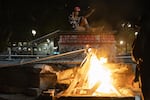
A protester sits where an elk statue used to stand during protests against racism and police violence in Portland, Ore., on July 16, 2020.
Jonathan Levinson / OPB
At first, activists viewed the agents as a minor nuisance compared to officers from the Portland Police Bureau, who for many nights before had used impact munitions and tear gas to drive demonstrators away from the building that houses the county jail and out of downtown Portland.
Sent there by President Donald Trump, the federal officers' stated goal was to protect federal buildings from damage and keep federal personnel safe. But by July 4, that mission shifted as federal officers cleared demonstrators blocks away from federal property. Over the next two weeks, their tactics became increasingly aggressive. They hospitalized at least one person and grabbed others off Portland streets and into unmarked vehicles.
Only after that last tactic gathered national headlines would the country take notice and ask: Was Portland really a “city under siege,” as acting Department of Homeland Security Secretary Chad Wolf described it? Protesters and journalists who regularly showed up at the nightly demonstrations agreed a siege was happening — but over 14 days, federal law enforcement increasingly became the occupying force.
Here is how we got here:
June 5

A night of protests against police brutality in Portland, Ore., ended with police using tear gas, flash bangs and rubber bullets to disperse the crowd June 5, 2020, after protesters threw water, fruit and bottles at police and then knocked down the fence separating them.
Jonathan Levinson / OPB
As in cities across the county, Portlanders turned out to protest racism and violence in the criminal justice system after police killed George Floyd in Minneapolis. After a week of widespread use of tear gas and impact munitions to disperse mostly nonviolent protesters, a federal judge issued a temporary restraining order against the Portland Police Bureau, limiting their use of tear gas to instances "in which the lives or safety of the public or the police are at risk."
In his order, U.S. District Judge Marco Hernandez said that, given the evidence, there was a “strong likelihood” the bureau had violated protesters’ Fourth Amendment rights, which prohibits unreasonable searches and seizures and covers excessive use of force.
June 26
The city and protesters agreed to expand the restraining order beyond tear gas, to include crowd control devices like pepper spray and rubber bullets. Portland police still continued to use tear gas and impact munitions, but the bar to justify their use was significantly higher. State lawmakers in the Oregon Legislature also passed a law requiring police to first warn protesters before using tear gas. Under the new law, officers must determine that a "riot" is occurring. Oregon law defines a riot as just five people acting in a violent manner.
Related: Portland Police Under Scrutiny For Dangerous Crowd Control Munitions
That same day, Trump signed an executive order to protect statues and monuments across the country and to combat what he described as “criminal violence” arising from protests against police violence and systemic racism.
The order came as statues of Confederate generals and other slave-owning historic figures were either removed or pulled down by protesters, including one of George Washington in Northeast Portland on the eve of the Juneteenth holiday and another of Thomas Jefferson days before that. In response, the Department of Homeland Security sent officers to Portland, Seattle, Gettysburg National Park in Pennsylvania and Washington, D.C. A U.S. Customs and Border Protection memo dated July 1 noted that the executive order created a DHS task force to "surge" federal law enforcement resources to protect against potential civil unrest. (The Nation first reported on the documents.)
July 1
Federal officers started playing a more obvious and active role during nightly protests in Portland, pulling protesters’ attention away from the Multnomah County Justice Center and refocusing it across the street on the Mark O. Hatfield Federal Courthouse. That night, federal officers emerged from the boarded-up courthouse to fire pepper balls at demonstrators who came too close to the building. Their appearance changed the protests.
"People felt like they knew what they were getting into with Portland police," said Portland-based independent journalist Tuck Woodstock, who has been covering the protests since late May. The protesters had specific demands for Portland police — they wanted officers held accountable for specific acts of violence and the bureau defunded.
Woodstock said that in the wake of the temporary restraining order, demonstrators felt like some accountability for the Portland Police Bureau was possible. Weeks before, protesters had successfully pressured city government to disband the bureau's controversial Gun Violence Reduction Team, end the school resource officer program and reallocate nearly $16 million from the police budget into community programs.
“With the federal officers, it feels like everyone in the city of Portland is almost powerless to hold them to any kind of account,” Woodstock said.
July 4
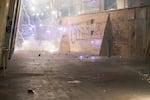
Fireworks go off outside the boarded up federal courthouse during 4th of July demonstrations against systemic racism and police violence. Protesters ate food, danced, burned American flags and set off fireworks before Portland Police and federal law enforcement used tear gas and impact munitions to disperse the crowd.
Jonathan Levinson / OPB
Hundreds of protesters gathered around the Multnomah County Justice Center and Mark O. Hatfield Federal Courthouse. Fireworks shows across the country, including Portland, had been canceled because of the pandemic, but protesters filled the gap.
After more than a month of police using tear gas, impact munitions and flash bang devices to disperse enormous crowds and largely nonviolent demonstrations, the protesters on Independence Day had a fireworks display of their own. They aimed at times at the two government buildings — and the government officers — who had come to represent everything the demonstrators were protesting: racism, police brutality and an unjust criminal justice system.
Just before 11 p.m, protesters fired a variety of fireworks, including some commercial-grade fireworks, at the federal courthouse. Some also aimed green laser pointers at the exterior. Demonstrators yelled at the officers hiding behind small hatches cut in the plywood facade of the boarded-up building; the holes were used as blinds to fire pepperball munitions on the crowd.
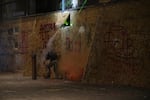
A federal law enforcement officer sprays a protester with pepper spray from inside the federal courthouse during 4th of July demonstrations against systemic racism and police violence. The officers later assisted PPB in dispersing hundreds of protesters from downtown.
Jonathan Levinson / OPB
After about 15 minutes, federal officers grew impatient. Officers from the U.S. Marshals Special Operations Group, Customs and Border Protection’s Border Patrol Tactical Unit or BORTAC, and the Federal Protective Service quickly filled the courthouse’s covered entryway with tear gas. Flash bangs detonated as protesters scattered, and officers poured out of the boarded-up front entrance.
From there, officers continued across the street into Lownsdale Square, a city park. They continued marching west, joined by the Portland Police Bureau, pushing the crowd farther and farther along city streets. By the time federal officers stopped marching, the line of law enforcement officers was blocks away from federal property at the courthouse.
July 8
After multiple failed strategies in response to the protests and a continued inability to end the nightly demonstrations, Portland Deputy Chief Chris Davis met with the media. He characterized the protesters as criminals who had co-opted a peaceful movement, a tried and true tactic used by government officials over the decades to delegitimize social movements. Protesters of nearly every stripe rejected the characterization.
Related: Activists Push Back Against Good Protester-Bad Protester Narrative
In response to the July 4 events, Davis said Portland’s police had no control over federal officers and that their presence made local officers’ jobs more difficult.
“I don’t have authority over federal officers,” Davis said. “They’re governed by their own policies and procedures. They’re acting under federal law, federal authority. … It does complicate things for us.”
Still, Davis said, an officer from the federal agencies was stationed in the Portland Police Bureau's nightly command post to coordinate as needed.
July 10
During a military briefing in Doral, Florida, Trump brought up the federal presence in the city of Portland unprompted. He said he had sent the officers to Oregon because “the locals couldn’t handle it.”
"It was out of control," the president said.
July 11
Protesters once again gathered at night in the city park across the street from the federal courthouse. They taunted federal officers, telling them to get out of Portland.
One demonstrator, 26-year-old Donavan La Bella, stood at the edge of the park closest to the courthouse. He held a boombox over his head with both hands. When a tear gas canister landed at his feet, he bent over and pushed it a few feet away. He stood back up and lifted the boombox again, and a U.S. marshal shot him in the head with an impact round, fracturing his skull and leaving him in critical condition.
Related: Federal Officers Shoot Portland Protester In Head With 'Less Lethal' Munitions
The shooting prompted outcry from Oregon elected officials. Gov. Brown said it was the result of Trump continuing to push for force and violence in response to protests.
Unlike several of his fellow city commissioners, the governor and Oregon’s two U.S. senators, Portland Mayor Ted Wheeler took almost 18 hours to respond. His written statement bemoaned the violence, but didn’t go as far as other elected officials in condemning federal behavior.
“I’m concerned that the actions of federal officers last night escalated, rather than de-escalated, already heightened tensions in our city,” said Wheeler, who is also Portland’s police commissioner.
July 13
U.S. Sen. Ron Wyden, D-Oregon, said Trump had a dangerous fixation with strong-arming peaceful protesters.
“What America does not need is Donald Trump parachuting federal law enforcement into U.S. cities as if they’re enemy strongholds requiring an occupying army to suppress,” Wyden said.
The next day, Sens. Wyden and Jeff Merkley, and U.S. Reps. Earl Blumenauer and Suzanne Bonamici — all Democrats — sent a letter to the Department of Homeland Security and Department of Justice seeking answers about the federal officers’ deployment in Portland.
At the White House, Trump said nothing of the injuries to protester LaBella, and praised the federal law enforcement’s response.
“We’ve done a great job in Portland,” Trump said. “Portland was totally out of control. They went in and I guess they have many people right now in jail. We very much quelled it. If it starts again, we’ll quell it again, very easily. It’s not hard to do.”
July 15
In the early morning hours of July 15, video surfaced on Twitter showing two officers in camouflage getting out of an unmarked van. They walked toward a person in a black hoodie and a helmet.
Officers put the person’s hands behind their back and walked them back to an unmarked van before driving away.
Related: Federal Law Enforcement Use Unmarked Vehicles To Grab Protesters Off Portland Streets
In a separate incident, around 2:30 a.m., Mark Pettibone was also grabbed by federal agents in camouflage.
"A van pulls up right in front of us," Pettibone later told OPB. "I am basically tossed into the van. I had my beanie pulled over my face so I couldn't see, and they held my hands over my head."
Pettibone said he was taken to the federal courthouse where federal officers searched and photographed him but gave no reason for his arrest.
“They patted me down, took my picture and rummaged through my belongings,” Pettibone said. “One of them said, ‘This is a whole lot of nothing.’ He seemed disappointed that I didn’t have any weapons or anything on me.”
Pettibone was placed in a cell by himself and read his Miranda rights, he said. Officers asked if he wanted to waive his rights, he said, but Pettibone declined and asked for a lawyer. He was released about 90 minutes later.
“It was clear to me that this was just a totally indiscriminate detainment,” Pettibone said.
Speaking in the Oval Office later that day with Attorney General Bill Barr, Trump again spoke about the protests in Portland and alluded to a larger role federal law enforcement could play in cities across the country, similar to Portland.
“We're doing a great job in Portland,” Trump said. “Portland was very rough and they called us in, and we did a good job, to put it mildly. Many people in jail right now. But we have other cities that are out of control. They're like war zones.”
July 16
Customs and Border Protection Commissioner Mark Morgan told Fox News that Trump was planning an announcement about enhanced federal law enforcement actions involving the Department of Justice and Homeland Security "next week."
“We’re going to do what needs to be done to protect the men and women of this country,” he said.
Department of Homeland Security Acting Secretary Chad Wolf also made an unannounced visit to Portland, where he toured graffiti on the federal courthouse and talked to federal officers and Portland Police Association President Daryl Turner.
Portland's mayor refused to meet with Wolf, saying he disapproves of the federal presence and that there’s nothing he can do to stop federal action. Oregon's governor told OPB she spoke with Wolf on the phone earlier in the week.
“I said, ‘Please take your officers home,'” Brown told OPB’s "Think Out Loud®." “'They are only escalating things here in the city and you need to go home.'"
Before leaving, Wolf went live on Sean Hannity’s show on Fox News, where he said the Department of Homeland Security would continue to have a presence in Portland despite opposition from local, state and federal officials from Oregon.
“We need to make sure that we’re supporting our law enforcement officers here and making sure that they’re continuing to protect the federal courthouse here; that’s what DHS does,” Wolf said. “We’re going to do our job, we’re going to do it professionally.”
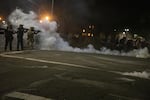
Federal law enforcement officers fire impact munitions and tear gas at protesters demonstrating against racism and police violence in front of the Mark O. Hatfield federal courthouse in Portland, Ore., on July 16, 2020.
Jonathan Levinson / OPB
Shortly after Wolf toured the federal courthouse, OPB published Pettibone’s story, confirming federal law enforcement agents have been grabbing protesters off the streets in unmarked vehicles and without giving any explanation to the people being detained.
The U.S. Marshals Service issued a statement denying their officers participated in Pettibone’s arrest. Homeland Security officials did not respond to written questions about the arrest.
July 17
National scrutiny of the Department of Homeland Security increased, with a fresh round of condemnation from Oregon lawmakers, as well as national figures such as Sen. Elizabeth Warren, D-Massachusetts, and House Speaker Nancy Pelosi, D-California.
U.S. Attorney for the District of Oregon Billy Williams stood on the steps of the federal courthouse in front of a large group of protesters and called for an investigation into the actions of DHS agents in Portland.
“Based on news accounts circulating that allege federal law enforcement detained two protesters without probable cause, I have requested the Department of Homeland Security Office of the Inspector General to open a separate investigation directed specifically at the actions of DHS personnel,” Williams said in a statement.
Later in the day, the ACLU of Oregon filed a lawsuit seeking to restrain how federal law enforcement interacts with journalists and legal observers at protests. The Oregon Department of Justice also sued federal agencies, and the Oregon attorney general said state prosecutors may pursue criminal charges against the officer who shot LaBella.
In a written statement, the Department of Homeland Security confirmed officers from Customs and Border Protection had been arresting protesters in Portland using unmarked vehicles. The agency defended the arrests as lawful and justified.
“In Portland, they have. I wouldn’t say this is used anywhere else,” Ken Cuccinelli, the acting deputy secretary of Homeland Security, told NPR. “Upon questioning, they determined they were — they did not have the right person — and that person was released.”
Cuccinelli said he didn't know if the case he was asked about was Pettibone’s and wouldn’t say how many times similar arrests involving unmarked vans have happened.
But he said the practice would continue.
“I fully expect that as long as people continue to be violent and to destroy property that we will attempt to identify those folks,” he said. “We will pick them up in front of the courthouse. If we spot them elsewhere, we will pick them up elsewhere. And if we have a question about somebody's identity — like the first example I noted to you — after questioning determine it isn't someone of interest, then they get released. And that's standard law enforcement procedure, and it's going to continue as long as the violence continues.”
July 18
The backlash against border patrol actions on Portland streets did little to deter federal law enforcement.
In the early hours of the morning, with no clear provocation, federal officers dressed in camouflage used tear gas, pepper balls and other impact munitions to push hundreds of protesters far from federal property. Portland police officers marched beside them at times. The scenes prompted Commissioner Jo Ann Hardesty to demand that Mayor Ted Wheeler turn over day-to-day management of Portland police to her.
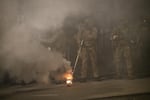
Federal law enforcement officers fire impact munitions and tear gas at protesters demonstrating against racism and police violence in front of the Mark O. Hatfield federal courthouse in Portland, Ore., on July 16, 2020.
Jonathan Levinson / OPB
After more than two weeks in Portland, federal officers have come to be seen as a wild card.
"PPB is usually predictable in their response to something," said freelance reporter Garrison Davis. "The federal officers are not. It's harder to get a sense of what their goal is and what they're going to do. It makes being there safely very difficult."
The increasingly aggressive actions by federal officers have also energized the protest movement in Portland, a city known for its cultural defiance to authority. Crowds grew significantly July 17 and 18.
At one point Friday night, a naked woman sauntered to a police line and pointed her finger at federal officers, who were dressed in camo and carrying less-than-lethal weapons. She dared the officers to shoot, and they obliged — spraying the ground inches from her feet with pepper balls.
The woman didn’t move.